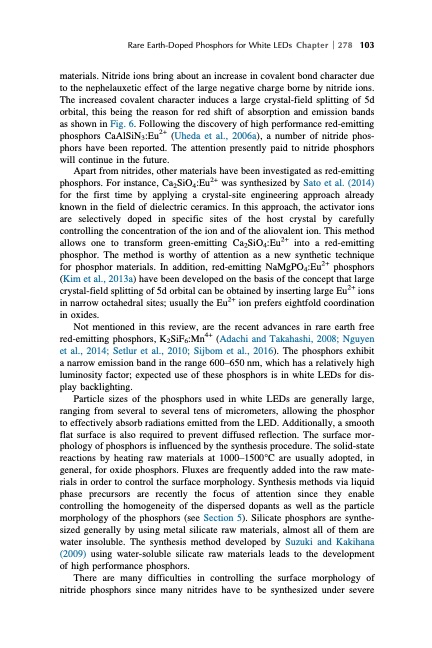
PDF Publication Title:
Text from PDF Page: 139
Rare Earth-Doped Phosphors for White LEDs Chapter 278 103 materials. Nitride ions bring about an increase in covalent bond character due to the nephelauxetic effect of the large negative charge borne by nitride ions. The increased covalent character induces a large crystal-field splitting of 5d orbital, this being the reason for red shift of absorption and emission bands as shown in Fig. 6. Following the discovery of high performance red-emitting phosphors CaAlSiN3:Eu2+ (Uheda et al., 2006a), a number of nitride phos- phors have been reported. The attention presently paid to nitride phosphors will continue in the future. Apart from nitrides, other materials have been investigated as red-emitting phosphors. For instance, Ca2SiO4:Eu2+ was synthesized by Sato et al. (2014) for the first time by applying a crystal-site engineering approach already known in the field of dielectric ceramics. In this approach, the activator ions are selectively doped in specific sites of the host crystal by carefully controlling the concentration of the ion and of the aliovalent ion. This method allows one to transform green-emitting Ca2SiO4:Eu2+ into a red-emitting phosphor. The method is worthy of attention as a new synthetic technique for phosphor materials. In addition, red-emitting NaMgPO4:Eu2+ phosphors (Kim et al., 2013a) have been developed on the basis of the concept that large crystal-field splitting of 5d orbital can be obtained by inserting large Eu2+ ions in narrow octahedral sites; usually the Eu2+ ion prefers eightfold coordination in oxides. Not mentioned in this review, are the recent advances in rare earth free red-emitting phosphors, K2SiF6:Mn4+ (Adachi and Takahashi, 2008; Nguyen et al., 2014; Setlur et al., 2010; Sijbom et al., 2016). The phosphors exhibit a narrow emission band in the range 600–650 nm, which has a relatively high luminosity factor; expected use of these phosphors is in white LEDs for dis- play backlighting. Particle sizes of the phosphors used in white LEDs are generally large, ranging from several to several tens of micrometers, allowing the phosphor to effectively absorb radiations emitted from the LED. Additionally, a smooth flat surface is also required to prevent diffused reflection. The surface mor- phology of phosphors is influenced by the synthesis procedure. The solid-state reactions by heating raw materials at 1000–1500°C are usually adopted, in general, for oxide phosphors. Fluxes are frequently added into the raw mate- rials in order to control the surface morphology. Synthesis methods via liquid phase precursors are recently the focus of attention since they enable controlling the homogeneity of the dispersed dopants as well as the particle morphology of the phosphors (see Section 5). Silicate phosphors are synthe- sized generally by using metal silicate raw materials, almost all of them are water insoluble. The synthesis method developed by Suzuki and Kakihana (2009) using water-soluble silicate raw materials leads to the development of high performance phosphors. There are many difficulties in controlling the surface morphology of nitride phosphors since many nitrides have to be synthesized under severePDF Image | HANDBOOK ON THE PHYSICS AND CHEMISTRY OF RARE EARTHS

PDF Search Title:
HANDBOOK ON THE PHYSICS AND CHEMISTRY OF RARE EARTHSOriginal File Name Searched:
Chemistry-Rare-Earths-49.pdfDIY PDF Search: Google It | Yahoo | Bing
Sulfur Deposition on Carbon Nanofibers using Supercritical CO2 Sulfur Deposition on Carbon Nanofibers using Supercritical CO2. Gamma sulfur also known as mother of pearl sulfur and nacreous sulfur... More Info
CO2 Organic Rankine Cycle Experimenter Platform The supercritical CO2 phase change system is both a heat pump and organic rankine cycle which can be used for those purposes and as a supercritical extractor for advanced subcritical and supercritical extraction technology. Uses include producing nanoparticles, precious metal CO2 extraction, lithium battery recycling, and other applications... More Info
| CONTACT TEL: 608-238-6001 Email: greg@infinityturbine.com | RSS | AMP |